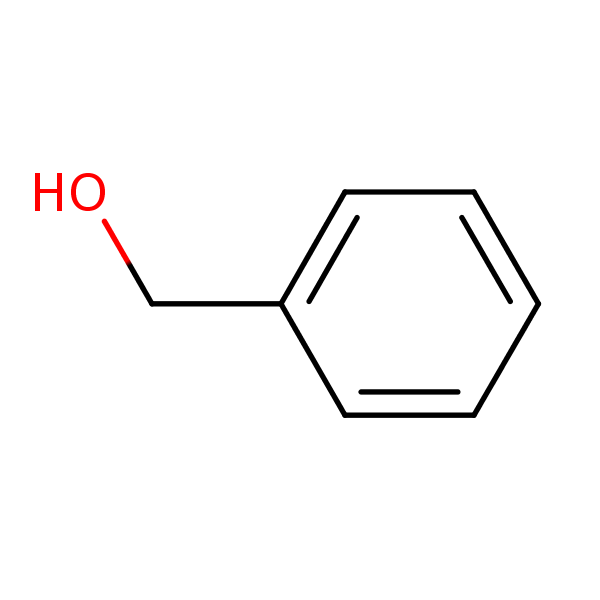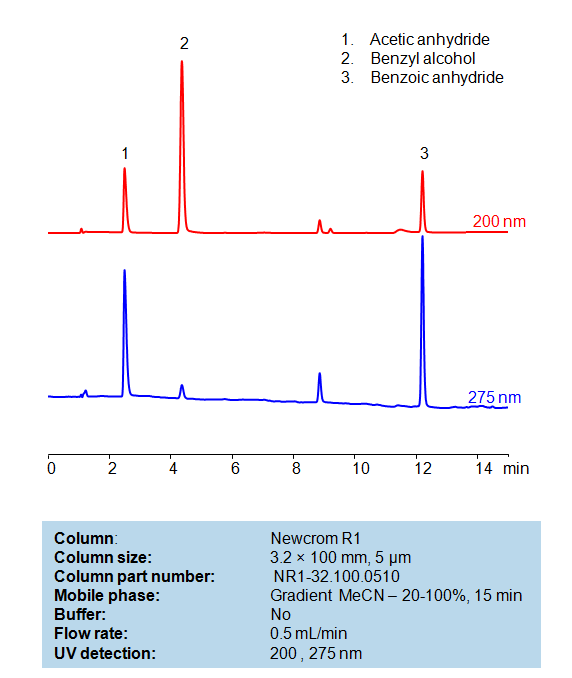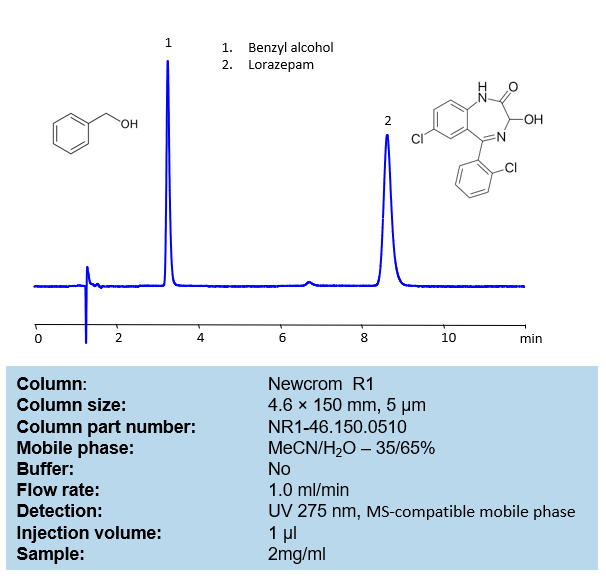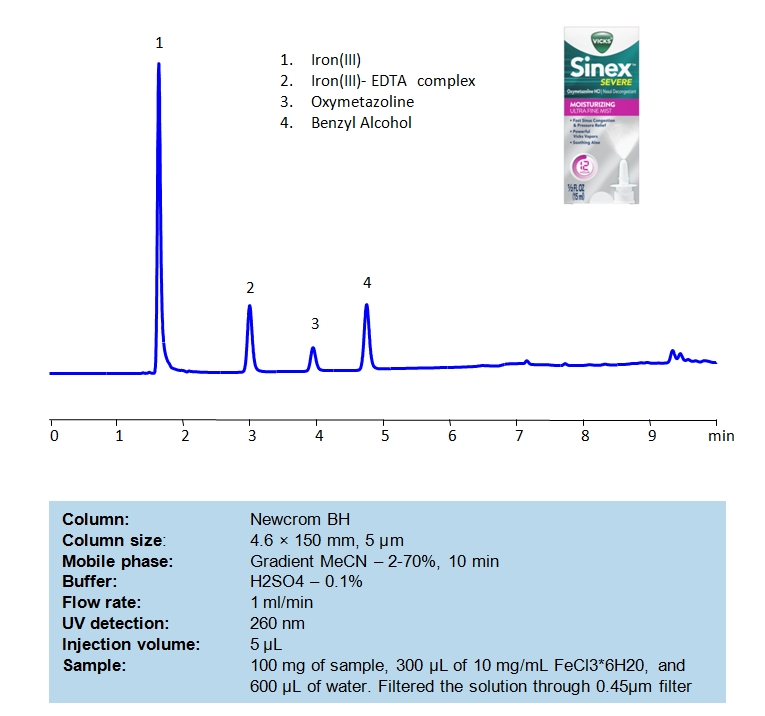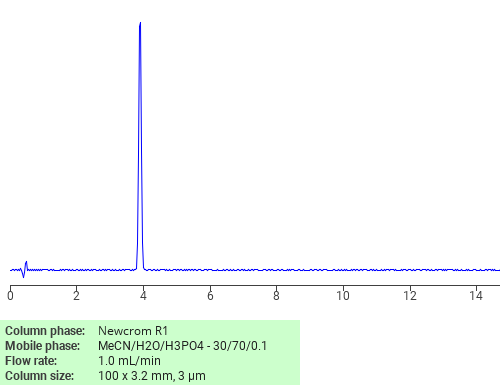| CAS Number | 100-51-6 |
|---|---|
| Molecular Formula | C7H8O |
| Molecular Weight | 108.140 |
| InChI Key | WVDDGKGOMKODPV-UHFFFAOYSA-N |
| LogP | 1.10 |
| Synonyms |
|
Applications:
HPLC Method for Estimation of Clotrimazole in Health Care Products on Primesep 200 Column
September 11, 2023
HPLC Method for Analysis of Clotrimazole, Benzyl alcohol, Ethylparaben on Primesep 200 by SIELC Technologies
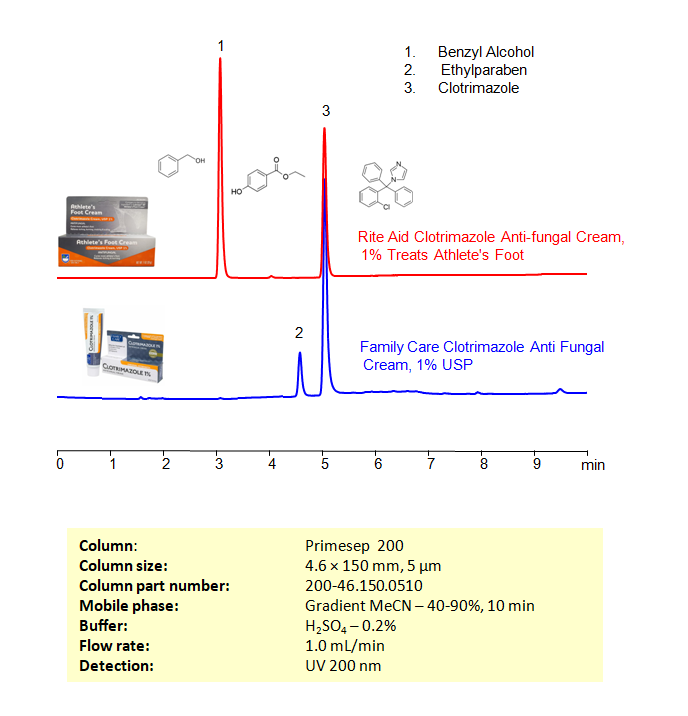
High Performance Liquid Chromatography (HPLC) Method for Analysis of Clotrimazole, Benzyl alcohol, Ethylparaben
Clotrimazole is an antifungal medication widely used in the treatment of fungal infections.
Description:
- Classification: Clotrimazole belongs to the class of medications called imidazole antifungals.
Uses:
- Topical: It’s commonly used to treat skin infections such as athlete’s foot, jock itch, ringworm, and other fungal skin infections (candidiasis).
- Vaginal: As a vaginal cream or tablet, it’s used to treat vaginal yeast infections.
- Otic (Ear): Clotrimazole solution can be used to treat fungal ear infections.
Mechanism of Action:
- Clotrimazole works by inhibiting the synthesis of ergosterol, a vital component of fungal cell membranes. When ergosterol synthesis is inhibited, it leads to structural and functional impairment of the fungal cell membrane, thereby killing the fungus or inhibiting its growth.
Clotrimazole belongs to the class of chemical compounds known as imidazoles. Specifically, it’s an antifungal compound used to treat fungal infections. Imidazoles work by inhibiting the enzyme lanosterol 14α-demethylase, which is necessary for the synthesis of ergosterol, an essential component of fungal cell membranes. When ergosterol synthesis is disrupted, it leads to alterations in the cell membrane’s permeability and, eventually, fungal cell death.
Other antifungal agents in the imidazole class include miconazole, econazole, and ketoconazole, among others. These are commonly used in various formulations to treat a range of fungal infections, including athlete’s foot, ringworm, and yeast infections.
Clotrimazole can be retained, and analyzed on a Primesep 200 mixed-mode stationary phase column using an isocratic analytical method with a simple mobile phase of water, Acetonitrile (MeCN), and a sulfuric acid as a buffer. This analysis method can be detected in the UV 200 nm.
| Column | Primesep 200, 4.6 x 150 mm, 5 µm, 100 A, dual ended |
| Mobile Phase | Gradient MeCN – 40-90%, 10 min |
| Buffer | H2SO4 – 0.2% |
| Flow Rate | 1.0 ml/min |
| Detection | UV, 200 nm |
| Class of Compounds | Imidazole antifungals |
| Analyzing Compounds | Clotrimazole, Benzyl alcohol, Ethylparaben |
Application Column
Primesep 200
Column Diameter: 4.6 mm
Column Length: 150 mm
Particle Size: 5 µm
Pore Size: 100 A
Column options: dual ended
Clotrimazole
Ethylparaben

HPLC Method for Analysis of Acetic Anhydride, Benzyl Alcohol and Benzoic Anhydride on Newcrom R1 Column
June 3, 2022
Separation type: Liquid Chromatography Reverse Phase.
High Performance Liquid Chromatography (HPLC) Method for Analysis of Acetic Anhydride, Benzyl Alcohol and Benzoic Anhydride
Acetic Anyhydride is a common reagent in organic synthesis, particularly in the acetylation of alcohols, amines, and aromatic rings. Benzyl Alcohol is a popular organic solvent and preservative used in topical drugs, cosmetics, and intravenous drugs. Benzoic Anhydride is the anhydride form of Benzoic Acid and a common reagent in organic synthesis. These 3 organic compounds can be separated and analyzed on a Newcrom R1 reverse-phase column using a simple gradient analytical method with a mobile phase consisting of just water and Acetonitrile (MeCN) (with no ionic modifier). This analysis method can be UV detected at 200 or 275 nm with high resolution and peak symmetry.
| Column | Newcrom R1, 3.2×100 mm, 100A |
| Mobile Phase | Gradient MeCN – 20-100% |
| Buffer | No |
| Flow Rate | 0.5 ml/min |
| Detection | UV 200, 275nm |
| Class of Compounds | Acid, Hydrophilic |
| Analyzing Compounds | Acetic Anhydride, Benzyl Alcohol and Benzoic Anhydride |
Application Column
Newcrom R1
The Newcrom columns are a family of reverse-phase-based columns. Newcrom A, AH, B, and BH are all mixed-mode columns with either positive or negative ion-pairing groups attached to either short (25 Å) or long (100 Å) ligand chains. Newcrom R1 is a special reverse-phase column with low silanol activity.
Select optionsBenzoic anhydride
Benzyl alcohol

HPLC Method for Lorazepam Injection on Newcrom R1 Column
July 22, 2021
HPLC Method for Lorazepam, Benzyl alcohol on Newcrom R1 by SIELC Technologies
High Performance Liquid Chromatography (HPLC) Method for Analysis of Lorazepam.
Lorazepam is a short-acting benzodiazepine medication commonly used as a sedative and anxiolytic of choice in the inpatient setting owing to its fast onset of action when administered intravenously. Lorazepam is one of the few sedative-hypnotics with a relatively clean side effect profile. It has the chemical formula C15H10Cl2N2O2.
You can find detailed UV spectra of Lorazepam, Benzyl alcohol and information about its various lambda maxima by visiting the following link.
Lorazepam can be retained in HPLC on Newcrom R1 reverse-phase column with the simple isocratic mobile phase consisting of acetonitrile (MeCN) and water. The analysis method can be UV detected at 275 nm.
| Column | Newcrom R1, 4.6 x 150 mm, 5 µm, 100 A, dual ended |
| Mobile Phase | MeCN – 35% |
| Buffer | No |
| Flow Rate | 1.0 ml/min |
| Detection | UV 275 nm |
| Class of Compounds | Hydrophobic, Drug |
| Analyzing Compounds | Lorazepam, Benzyl alcohol |
Application Column
Newcrom R1
Column Diameter: 4.6 mm
Column Length: 150 mm
Particle Size: 5 µm
Pore Size: 100 A
Column options: dual ended
Lorazepam

HPLC Separation of EDTA, Oxymetazoline and Benzyl Alcohol in Nasal Spray
September 4, 2020
HPLC Method for EDTA (Ethylenediaminetetraacetic Acid), Oxymetazoline, Benzyl alcohol, Oxymetazoline hydrochloride on Newcrom BH by SIELC Technologies
High Performance Liquid Chromatography (HPLC) Method for Analysis of EDTA, Oxymetazoline and Benzyl Alcohol
Benzyl alcohol is found in over-the-counter medications, topical creams, lotions, shampoos, and facial cleansers as an antibacterial, preservative, and/or fungicide. Benzyl alcohol is a colorless liquid with a mild pleasant aromatic scent. Benzyl alcohol is found in many essential oils including jasmine, hyacinth, neroli, rose, and ylang-ylang. Oxymetazoline is a decongestant that shrinks blood vessels in the nasal passages. All active compounds of nasal spray can be separated in HPLC on a Newcrom BH mixed-mode column. The analytical method uses acetonitrile (ACN) gradient and water with sulfuric acid (H2SO4) as buffer and UV detected at 260nm.
| Column | Newcrom BH, 4.6 x 150 mm, 5 µm, 100 A, dual ended |
| Mobile Phase | Gradient MeCN – 2- 70%, 10 min |
| Buffer | H2SO4 – 0.1% |
| Flow Rate | 1.0 ml/min |
| Detection | UV 260nm |
| Class of Compounds | Acid, Hydrophilic, Preservatives |
| Analyzing Compounds | EDTA (Ethylenediaminetetraacetic Acid), Oxymetazoline, Benzyl alcohol, Oxymetazoline hydrochloride |
Application Column
Newcrom BH
Column Diameter: 4.6 mm
Column Length: 150 mm
Particle Size: 5 µm
Pore Size: 100 A
Column options: dual ended
EDTA (Ethylenediaminetetraacetic Acid)
Oxymetazoline
Oxymetazoline hydrochloride

Separation of Benzyl alcohol on Newcrom R1 HPLC column
February 16, 2018
Benzyl alcohol can be analyzed by this reverse phase (RP) HPLC method with simple conditions. The mobile phase contains an acetonitrile (MeCN), water, and phosphoric acid. For Mass-Spec (MS) compatible applications the phosphoric acid needs to be replaced with formic acid. Smaller 3 µm particles columns available for fast UPLC applications. This liquid chromatography method is scalable and can be used for isolation impurities in preparative separation. It also suitable for pharmacokinetics.
Application Column
Newcrom R1
The Newcrom columns are a family of reverse-phase-based columns. Newcrom A, AH, B, and BH are all mixed-mode columns with either positive or negative ion-pairing groups attached to either short (25 Å) or long (100 Å) ligand chains. Newcrom R1 is a special reverse-phase column with low silanol activity.
Select options